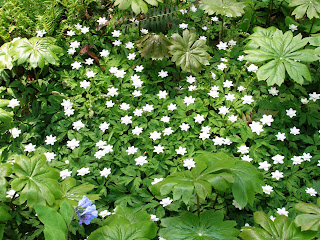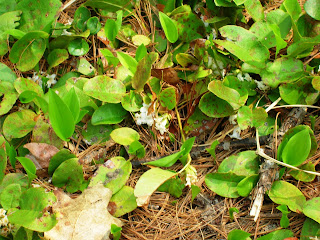Tuesday morning, I drove out to Framingham, about half an hour from the northwestern suburb where my cousin lives. There I visited the beautiful Garden in the Woods. This is a lovely place run by the New England Wildflower Society, and is exactly what the name says it is. The plants are cultivated to appear wild; if it weren't for the information signs, you would think you were in a natural wood. Parts of it actually are completely natural, too. The primary goal is to preserve native species of plants that are in danger from habitat loss, over-harvesting, and invasive species. I got there just in time for a guided tour, which I hadn't been planning on but I'm glad I did.
As you can see, the terrain is quite hilly. This is partly due to glacial activity, and partly due to the railroads mining the gravel created by the glaciers. Having such a varied topography allows for a lot of different habitats in a relatively small space.
This place was interesting to me partly because I've never lived in that part of the country (or at least not since age 3), so a lot of the plants that are common in New England are unusual to me. Things as simple as anemones, trilliums, and bleeding hearts, for instance.
Then there were things I was familiar with having grown up in Georgia, but the growing season is of course very different.
At my parents' house the week before, the azaleas and dogwoods were already over, while here they were barely getting started. Not surprising, of course. But the thing that really made me do a double take was the magnolia.
In Georgia, the magnolias are evergreens. I grew up believing that they all were, but it turns out in northern latitudes they shed their leaves like other trees. It was actually a bit of a shock to me to see a perfectly healthy magnolia with no leaves.
In the lower parts of the garden are wetlands, some natural, some created.
A created lily pond...
... complete with fiddlehead ferns and frogs. There are several other wetlands as well, but I don't have room to show all the pictures.
This tiny little flower is called a trailing arbutus.
It's the state flower of Massachussetts, and is also known as the mayflower. They told me the boat was named after a similar flower back in Europe, and when the pilgrims got to Massachussetts and found this flower, they called it a mayflower as well.
A few more pictures from the garden, and then on to then next thing.
Much as I would have liked to stay and play in the woods all day, there was one other thing I wanted to do. So I drove back to Boston, realized I had left my camera at the gift shop at Garden in the Woods, drove all the way back out to Framingham to get it, and back to Boston again. By this time I had to skip lunch, but at least it was a pretty drive.
Back in Boston, I took a tour of the major historical sites, complete with a guide in 18th century costume. The guide was highly entertaining as well as being very knowledgeable. He kept saying things like, "The British Army's encampment was right about where that Bank of America building is. As you should have gathered by now, the British Army was seen as a hated and oppressive force-- much like the Bank of America today, come to think of it." I don't have time or space to tell you everything, but I'll try to hit the highlights.
The Granary Burying Ground contains the graves of several revolutionaries.
Here lies all of John Hancock except his right hand. You would think that John Hancock, of all people, ought to have managed to sign his will, but somehow he didn't and his widow got nothing. A widow wouldn't have automatically inherited back then unless her husband actually made a will in her favor; I guess he had to vouch for the fact that she was capable of handling money on her own or something. Well, she was so furious that she got her revenge by spreading the word that Hancock had been buried in all of his finest clothes; in short order the grave robbers broke in and stole everything. But (I hope you're not eating), he was so bloated in death that the thieves couldn't get the ring off his right hand, so they cut the whole hand off and carried it away. Presumably they did manage to get the ring off eventually, but the hand was never recovered.
Robert Treat Paine, another signer of the Declaration of Independence and grandfather of the man who owned the house where my cousin got married, is also buried here. Paine was such a gifted lawyer that he rarely ever lost a case. One of the few cases he did lose was when he was prosecuting the soldiers who committed the Boston Massacre. The defense lawyers (one of whom was John Adams) were inexperienced and unknown, and there was really no reason why Paine should have lost this case. Since all the lawyers involved were members of the Sons of Liberty, there is some speculation that they might have conspired to throw the case. If the soldiers had been convicted, the people of Boston would likely have been satisfied; but with an acquittal, they became furious enough to spark the Revolution sooner than it might otherwise have happened. Some people think that this was Paine's plan, though of course this can never be proven one way or the other.
In addition to being the Old City Hall, this is also the original site of the Boston Latin School, the first public school in North America. It was free and anyone could go there; by "anyone", of course, they meant white males whose fathers were landowners. Seems to me that at that time landowners would have been well-to-do enough that they could have sent their sons to private school, so I don't really know what the point was if they weren't really going to educate everybody. Different times. The statue in front is the school's most famous drop-out, Benjamin Franklin. The Latin School still exists, in a new location; today of course it really is open to anybody.
This building was the home of religious leader Ann Hutchinson, who got herself in trouble with the Puritans for thinking independently and encouraging others to do the same. Later it became the site of the Corner Bookstore, which was also a publishing house, publishing the works of Longfellow, Hawthorne, and the American editions of Dickens, among others. It's empty now, but hey, who needs a unique historical bookshop when you have this place right across the street?
Here's the Old North Church, where many pre-Revolution meetings were held, including the one that led to the Boston Tea Party.
This is the first Massachussetts State House building. The balcony is the site of the first reading of the Declaration in Independence in Massachussetts.
The Declaration is still read from the balcony every July 4th. One year, Queen Elizabeth II was in the audience. The state of Massachussetts presented her with a check to cover the cost of the tea that was dumped into the harbor; that check is now in the British Museum. Our guide said, "And I hope they never try to cash it, because we don't have the money now."
Finally, if you're ever in Boston and they ask you, "What flies over Faneuil Hall?" you'd better know the answer, or you could get arrested as a spy and a traitor. It's not a flag.
Grasshopper. Of course.
I would have loved to stay a couple more days, but Wednesday I had to fly home. As soon as I got home, I called to Squijum. After a minute or two, he came out from under the bed, yowled at me, ran over to be petted, yowled, rubbed against my legs and face, yowled some more, and licked my hand while still yowling. When I went to bed that night, he planted himself firmly on top of me to make sure that I would not leave again.
Whew. Thanks for sticking with me this far. The next post will be lacy.



























Very interesting, lovely piece of writing, I was born on the 4th July, only we dont have a bank holiday, I would love to have the day off on my birthday, I was interested in hearing the document about the indepence is still read out. I dont think I shall ever get to Boston, but at least I know a lot more about Boston than I did. thank you for sharing your holiday.
ReplyDeleteMargaret
I've certainly enjoyed reading your posts about your trip. You have excellent writing skills!
ReplyDeleteI was a 'late bloomer' (age 40) in acquiring my now very deep interest in and passion for American history. It was in 1976 during the Bicentennial when I realized how little I knew. Since that time I've made it a point to learn as much as possible (lots of books and magazines) and to visit important sites wherever we travel. I am lucky to have cousins living in New England, which gives DH and I the opportunity to visit the historic sites during our trips there. We've been to Boston several times. It was a treat to go onboard the Constitution ("Old Ironsides").
I never knew that story about John Hancock (yikes!), and forgot about the grasshopper! The amazing thing is, the Colonial era wasn't that long ago, and I can't even imagine what those folks would think of our 'electronic' age - not to mention our lifestyle and 'fashions'!
I've enjoyed visiting the Southern states, too!
I'm glad you received such an enthusiastic welcome home from Squijum!
That stuff about John Hancock was completely made up.
ReplyDelete